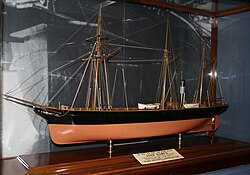John Bowes (ship)
|
Model of the John Bowes
|
||||||||||||
|
||||||||||||
|
||||||||||||
|
||||||||||||
|
||||||||||||
|
||||||||||||
The John Bowes was the first modern bulk carrier .
prehistory
In 1847, seventeen-year-old Charles Mark Palmer joined a coke-making company in north-east England as a partner to Sir William Hutt, Nicholas Wood and John Bowes. For around ten years, the coal company was faced with the situation that the transport of its own coal in collier-briggs , known as collier-briggs , to London was delayed by bad weather, while coal mines from the Midlands were already sending their material south via the growing railway network. After the bad weather period, almost all coal sailors arrived in London at the same time, which led to an oversupply of coal and correspondingly poor sales prices. To remedy this, Palmer founded the General Iron Screw Collier Company with London investors in April 1852 to transport coal from north-east England to London with screw-driven iron coal steamers . The coal ships or necklaces required for this were built at the Palmer Brothers shipyard in Jarrow, which was specially founded with his brother George .
The John Bowes
As the first of around 25 built units of this first type of bulk carrier, the John Bowes was launched on June 30, 1852 . The ship, built of iron, had bridge superstructures arranged aft and in front of it a hold with a hatch about twenty meters long. The drive consisted of a composite steam engine also installed aft from the manufacturer Thompson, Boyd & Company from Newcastle and three masts with schooner rigging. After the completion of the new building, which cost around 10,000 pounds, it began its first journey with a cargo of coal from the Tyne to London on July 29, 1852 and arrived on the Thames on July 31 . After unloading the cargo, the John Bowes completed her first return voyage on August 3rd. At first, the ballast tanks had leakage problems that could only be solved by installing separate built-in tanks.
The Collier-Briggs used on this coal transport at the time needed two to four weeks for a round trip. In conjunction with the special agreements that Palmer concluded with the London railway companies for faster coal distribution, the innovation quickly proved to be clearly superior to conventional transport by sailing ships .
After the ship was equipped with a new steam engine in 1864, Palmers' Iron Screw Collier Company sold the John Bowes in 1873 to Benjamin George Barnett in London, who continued to operate the ship under the old name and again a new steam engine in 1883 built in, supplied by M. Paul & Company from Dumbarton. In 1889 the ship came into Norwegian possession for a short time and was temporarily used as a spec for Frithjof Ohens, who in the same year passed it on to a Swedish shipping company that named the ship Transit . In December 1908 the shipping company de Ybarary from Bilbao acquired the steamer for 2000 pounds and operated it as Carolina until 1919 . In 1919 the ship was sold again and moved within Spain to the shipping company T. Fierro & Hijos in Gijón, which used it as Valentin Fierro . Later in the 1920s, the name of the operator's shipping company changed to Cia. Naviera Fierro and towards the end of the 1920s the steamer was registered with Frederico G. Fierro, in 1933 the freight steamer, now over 80 years old, changed hands for the last time and went into the hands of the shipping company Cia. Naviera Fierro in Madrid, who renamed it Villa Selgas . On October 10, 1933, the ship finally sank in bad weather on a trip with iron ore from Bilbao to San Sebastian.
Shipbuilding importance
The importance of the John Bowes in shipbuilding as the first modern bulk carrier lies in the combination of several things. At the time Palmer entered the coal business, 924 steamers were already in service around the world, but the draft of an iron steamship with screw drive and the possibility of taking water ballast on board, designed exclusively for bulk cargo transport, was still new in the mid-19th century. The steam drive made the ship independent of the weather and thus allowed a higher number of reliable journeys. The ship's propeller allowed better fuel efficiency than the paddle wheel drive, which benefited the load-bearing capacity. In addition, the construction made of iron reduced the weight, which also increased the load-bearing capacity. The water ballast in turn enabled a faster port turnaround time and also cost savings, because it was free and could be pumped to and overboard quickly - Collier-Briggs, on the other hand, were forced to buy ballast stones or sand ballast at the discharge port, which was time-consuming to load and delete it again in the loading port. The overall design of the ship formed the basis for the development of the classic tramp steamer and all subsequent bulk carriers.
At the foot of the statue of Sir Charles Mark Palmer, inaugurated in Jarrow in 1904, there are two large images of ships, one of John Bowes and one of HMS Resolution . The main inscription only mentions the John Bowes .
literature
- Martin Stopford: Maritime Economics . 2nd Edition. Routledge, Oxon, New York 1997, ISBN 0-415-15310-7 .
- Story of the Tramp Steamer in: The Age. November 6, 1948, p. 7 (English)
Web links
- Post at Port Cities Southampton (English)
- The John Bowes at wrecksite (English)
Individual evidence
- ^ Martin Stopford: Maritime Economics . 2nd Edition. Routledge, Oxon, New York 1997, ISBN 0-415-15310-7 , pp. 19/20 .
